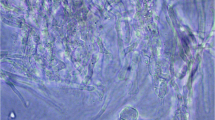Abstract
Parasitella parasitica (synonyms: P. parasitica and Mucor parasiticus) is a heterothallic facultative mycoparasite which belongs phylogenetically to the Mucor group within the zygomycetes. It is a facultative parasite of several but not all mucoraceous fungi. The interactions between host and parasite present several peculiarities. (1) Infection of the host organism Absidia glauca especially is strongly mating type-specific. (+) strains of P. parasitica will infect exclusively (-) strains of A. glauca whereas (-) strains of the parasite are required for the infection of (+) type hosts. We propose the hypothesis that host/parasite recognition is mediated by the same gamone system as is required for communication between sexual partners within mucorales (trisporic acid). (2) P. parasitica is a fusion biotroph. Infection is accompanied by a limited cytoplasmic continuum between the two partners, which allows invasion of the host by nuclei of the parasite. P. parasitica is not very aggressive. The host, A. glauca survives the infection well and forms normal sporangiospores even close to infection sites. We were able to demonstrate by genetic and molecular techniques that genetic markers of the parasite are transferred into the host’s nuclei at high rates. Absidia and Parasitella form a naturally occurring parasexual system with high efficiency. (3) Sexually compatible pairs of P. parasitica are not able to form zygospores. In order to reproduce sexually at least one of the partners has to grow parasitically. Measurements of trisporic acid levels in cocultures of P. parasitica with A. glauca led us to assume that interaction with a host organism is required for the cooperative synthesis of trisporic acid at a level high enough to induce sexual differentiation.
Access this chapter
Tax calculation will be finalised at checkout
Purchases are for personal use only
Preview
Unable to display preview. Download preview PDF.
Similar content being viewed by others
References
Burgeff H (1924) Untersuchungen über Sexualität und Parasitismus bei Mucorineen. I. Bot Abh 4: 1 – 13
Burmester A (1992) Transformation of the mycoparasite Parasitella simplexto neomycin resistance. Curr Genet 21: 121–124
Burmester A (1995) Analysis of the gene for the elongation factor 1 alpha from the zygomycete Absidia glauca. Use of the promoter region for constructions of transformation vectors. Microbiol Res 150: 63 – 70
Burmester A, Wöstemeyer J (1986) Cloned mitochondrial DNA from the zygomycete Absidia glaucapromotes autonomous replication in Saccharomyces cerevisiae. Curr Genet 10: 435 – 441
Burmester A, Wöstemeyer J (1994) Variability in genome organization of the zygomycete Parasitella parasitica.Curr Genet 26: 456–460
Czempinski K, Kruft V, Wöstemeyer J, Burmester A (1996) Purification of 4-dihydro-methyl-trisporate dehydrogenase from Mucor mucedo, an enzyme of the sexual hormone pathway, and cloning of the corresponding gene. Microbiology 142: 2647 – 2654
Goff LJ, Coleman AW (1984) Transfer of nuclei from a parasite to its host. Proc Natl Acad Sei USA 81: 5420 – 5424
Hänfler J, Teepe H, Weigel C, Kruft V, Lurz R, Wöstemeyer J (1992) Circular extrachromosomal DNA codes for a surface protein in the (+) mating type of the zygomycete Absidia glauca. Curr Genet 22: 319 – 325
Jeffries P, Young TWK (1994) Interfungal parasitic relationships. CAB Int., Wallingford.
Kellner M, Burmester A, Wöstemeyer A, Wöstemeyer J (1993) Transfer of genetic information from the mycoparasite Parasitella parasiticato its host Absidia glauca. Curr Genet 23: 334 – 337
Selker EU (1990) Premeiotic instability of repeated sequences in Neurospora crassa.Ann Rev Genet 24: 579–613
Vetter M, Wöstemeyer J, Burmester A (1994) Characterization of specific cDNA clones of the zygomycete Parasitella parasitica, derived from mRNAs which are regulated by the pheromone trisporic acid. Microbiol Res 149: 17 – 22
Wöstemeyer A, Teepe H, Wöstemeyer J (1990) Genetic interactions in somatic inter-mating type hybrids of the zygomycete Absidia glauca. Curr Genet 17: 163 – 168
Wöstemeyer J, Brockhausen-Rohdemann E (1987) Inter-mating type protoplast fusion in the zygomycete Absidia glauca.Curr Genet 12: 435–441
Wöstemeyer J, Burmester A ( 1986 Structural organization of the genome of the zygomycete Absidia glauca: evidence for high repetitive DNA content. Curr Genet 10: 903 – 907.
Wöstemeyer J, Wöstemeyer A, Burmester A, Czempinski K (1995) Relationships between sexual processes and parasitic interactions in the host-pathogen system Absidia glauca-Parasitella parasitica. Can J Bot 73: Suppl 1, S243 – S250
Wöstemeyer J, Wostemeyer A, Voigt K (1996) Horizontal gene transfer in the rhizosphere: a curiosity or a driving force in evolution? Adv Bot Res 24: 399 – 429
Author information
Authors and Affiliations
Editor information
Editors and Affiliations
Rights and permissions
Copyright information
© 1997 Springer-Verlag Berlin Heidelberg
About this paper
Cite this paper
Wöstemeyer, J., Wöstemeyer, A., Burmester, A., Czempinski, K. (1997). Gene Transfer from the Zygomycete Parasitella parasitica to its Hosts: An Evolutionary Link Between Sex and Parasitism?. In: Schenk, H.E.A., Herrmann, R.G., Jeon, K.W., Müller, N.E., Schwemmler, W. (eds) Eukaryotism and Symbiosis. Springer, Berlin, Heidelberg. https://doi.org/10.1007/978-3-642-60885-8_11
Download citation
DOI: https://doi.org/10.1007/978-3-642-60885-8_11
Publisher Name: Springer, Berlin, Heidelberg
Print ISBN: 978-3-642-64598-3
Online ISBN: 978-3-642-60885-8
eBook Packages: Springer Book Archive




